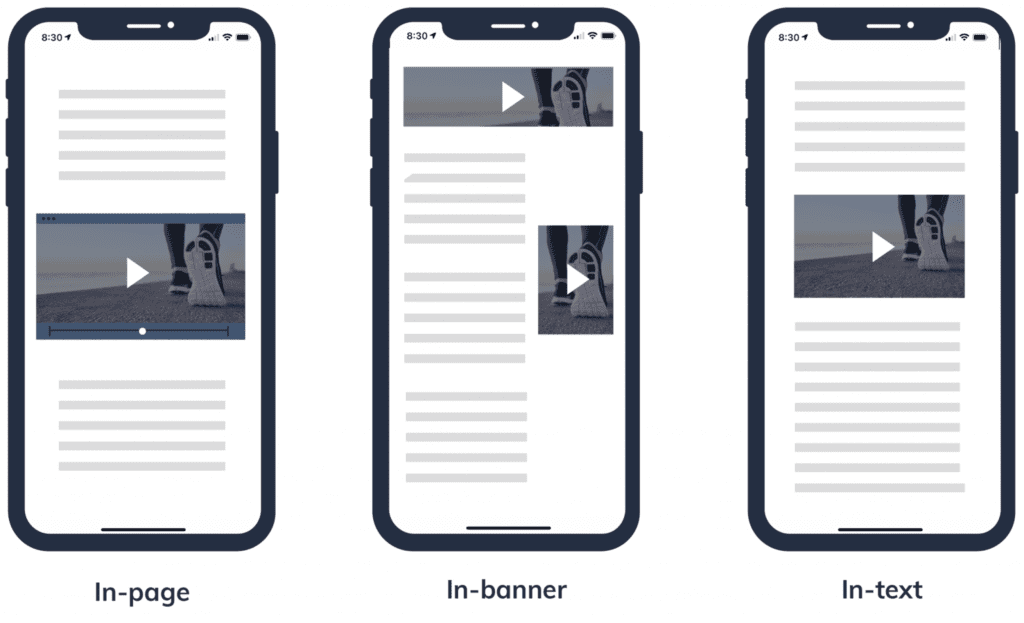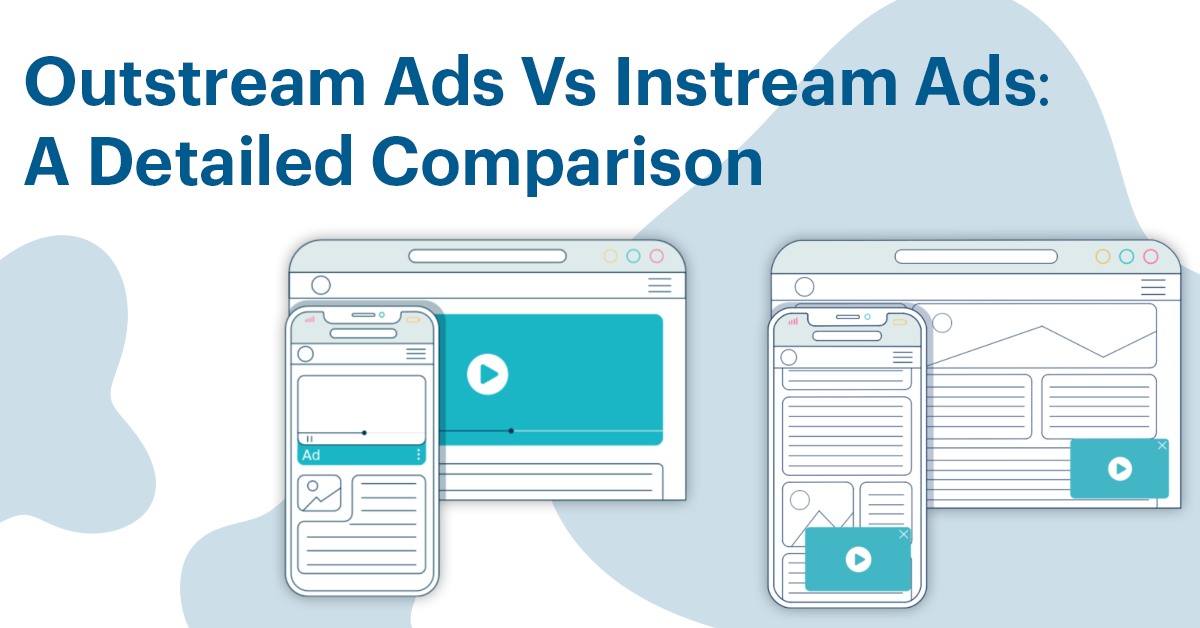Today’s digital world makes streaming videos an integral part of life for many of us, whether browsing YouTube tutorials or binging series on streaming services like Hulu and Netflix. Unfortunately, advertisements interrupt this viewing experience often, advertisements generally fall into two main categories – Instream Ads and outstream Ads .This blog Will explain about instream ads Vs outstream ads.
Let’s explore the differences between instream ads Vs outstream ads.
What Are Instream Video Ads?
Instream video ads are brief videos crafted to capture viewers’ attention while they engage with the content. There are different categories for Instream Ads that you could consider for these types of video advertisements:
Linear Ads
Linear ads appear at fixed intervals during videos.
There Are Three Main Types of Linear Ads
Pre-Roll Ads: Pre-roll ads run at the beginning of video content and usually feature short advertisements to set the stage for viewers’ experiences.
Mid-Roll Ads: Mid-roll ads interrupt videos at specific points during longer content to provide breaks for viewers and break up monotonous watching experiences.
Post-Roll Ads: Post-roll ads allow advertisers to leave an indelible mark on viewers by running after the main video has finished playing and leaving viewers with lasting memories of what you say or see in this advertisement.

Non-Linear Ads
These ads appear concurrently with video content without interrupting playback.
There Are Three primary Categories of Non-Linear Ads:
Overlay Banners: These ads appear over a main video to add extra information or interactive elements.
Text Ads: Text ads may appear alongside videos to provide context or additional details.
Canvas Ads
These ads appear alongside the main video content, next to its player. They enable advertisers to convey additional messages using images or text.

Advantages of Instream Ads
There are various advantages associated with instream video ads for marketers:
High Engagement: Incorporating them in video content increases audience interest and attention.
Captive Audience: People already watching your video will likely recognize and remember these advertisements more readily than those who just pass by.
Visual Impact: The video’s combination of sight, sound, and motion makes it an engaging storytelling medium.
Targeted Reach: Ads designed specifically to reach certain demographics can ensure they get the appropriate audience and effectively deliver your message.
Limitations of Instream Ads
While instream ads offer many advantages, they also possess certain drawbacks:
Ad Fatigue: Overexposure may lead to viewer fatigue and cause them to skip ads or develop blocking behaviors.
Viewer Resistance: Some viewers may find these ads intrusive and disrupt their viewing experience.
Ad Blockers: Many users employ software designed to block advertisements from appearing. This may prevent some from showing, thus saving space on mobile screens for other content that needs to be displayed.
Outstream Video Ads
Outstream Video Ads have emerged as an exciting new means to engage audiences beyond traditional video content. While in-stream ads remain tied to specific video players, out-stream ads exist independently from these players and can take multiple formats.
Types of Outstream Ads
In-Page Ads: These ads appear and disappear as users scroll across a website, typically expanding from their original position without interfering with user experience.
In-Text Ads: These advertisements play automatically as users scroll to them within articles or blog posts, becoming part of the written material and giving readers an immersive reading experience.
In-Banner Ads: These hybrid banner ads combine video with traditional banner advertisements for an interactive experience when clicked or hovered over. Expanded versions reveal video footage when expanded, providing users with an immersive viewing experience.

Benefits of Outstream Ads
Reach: They can appear across various platforms, increasing visibility and engagement with potential viewers.
Experience: Ads are designed to provide less disruptive experiences and allow users to interact with them freely.
Increased Viewability: Outstream ads only play when visible on the screen, which helps improve engagement metrics.
Challenges with Outstream Ads
Lower Engagement Rates: Display ads may fail to capture attention as effectively, leading to decreased engagement rates and rates of return for viewing them.
Low User Interaction: Their effectiveness depends heavily upon user participation, such as clicking or hovering.
Contextual Integration: Misplaced Outstream Ads may interrupt user experience if they seem out of place and misleading.
Comparing Instream Vs Outstream Ads User Experience
| Aspect | Instream Ads | Outstream Ads |
| User Experience | Captive audiences but can become intrusive if they interrupt viewing too frequently. | Less intrusive experience, encourages voluntary engagement for greater satisfaction and brand perception. |
| Ad Placement and Integration | Attract viewers while they watch videos, offering participation options at specific points. | Appear across various media types (articles, social media feeds), targeting audiences in familiar environments. |
| Monetization and Revenue Potential | Content creators and publishers generate income via video monetization with advertiser payment. | Publishers generate revenue by selling advertising space within articles and social media posts, no video content needed. |
| Engagement | Higher engagement due to user interaction requirements. | Potentially lower engagement levels as they do not require user interaction. |
| Viewability | Could potentially be skipped over or ignored. | Typically greater viewability since they only play when visible. |
| Message Delivery | Offers an aligned narrative experience. | Allows more flexible messaging in specific contexts. |
Consider Your Objectives While Selecting Instream and Outstream Ads
Before choosing between instream or outstream video ads on Instagram and other platforms like YouTube or Vine, consider your campaign objectives, target audience, and where users should engage based on this step-by-step approach:
Make Your Campaign Goals Clear
Start by outlining your campaign goals.To increase brand recognition, drive sales or tell an interesting narrative? Understanding these objectives will guide your selection between advertising formats.
Acknowledging Your Audience Understand what attracts your target audience best, do they react better to immersive experiences (instream) or prefer nonintrusive, low key interactions (outstream)?
Consider Context
Be mindful of the context for your ad placement; Instream may be appropriate if it integrates directly with certain video content, while Outstream may work best when targeting various platforms and media types.
User Experience
Think carefully about how you want users to perceive your ads, instream may provide higher levels of engagement while outstream ads offer a less intrusive solution.
Engagement or Interaction
Define what level of engagement you seek, instream ads can capture immediate interest while outstream ones depend upon users being willing to interact.
Platform Strategy
Identify where your audience spends their time. If they visit multiple websites and social networks, outstream ads could effectively reach them in those spaces.
Publishers: Are They Implementing Both Types of Ads?
Many publishers successfully incorporate instream and outstream ads into their monetization strategies to ensure maximum engagement and revenue. This hybrid approach diversifies monetization options, helping to maximize engagement while diversifying revenue sources.
Benefits of Hybrid Approach
Combining both Ad Types for Diversified Revenue Streams: Merging both opens new revenue opportunities, instream ads help monetize video content, while outstream ads generate non-video revenue streams.
Increased User Experience: With its hybrid approach, hybrid strategies meet the needs of a broad audience. Users who prefer less disruption may engage with outstream ads, while others can appreciate in-stream ones.
Targeted Monetization: Specific sections may be ideal for specific ad formats, optimizing campaign effectiveness.
Platform Adaptability: By offering both types, publishers can adapt their strategies across platforms for optimal ad placements.
Catering to Audience Preferences: An array of advertising tactics can increase user satisfaction by meeting individual preferences for advertising experiences.
Final Thoughts
Video Ads can be powerful tools in digital advertising’s arsenal, offering in-stream ads the flexibility of seamlessly fitting with video content while out-stream ads provide greater platform versatility. Each format brings its own set of benefits and challenges; choosing one should depend on campaign goals, audience behavior patterns, and desired user experiences.

